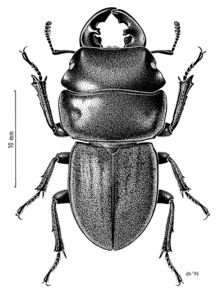Geodorcus auriculatus
Geodorcus auriculatus is a large flightless stag beetle that is found in the southern part of the Coromandel Peninsula and on Mount Te Aroha in the Kaimai range of New Zealand.
| Geodorcus auriculatus | |
|---|---|
 | |
| Female, illustrated by Des Helmore | |
 | |
| Male, illustrated by Des Helmore | |
| Scientific classification | |
| Kingdom: | Animalia |
| Phylum: | Arthropoda |
| Class: | Insecta |
| Order: | Coleoptera |
| Family: | Lucanidae |
| Genus: | Geodorcus |
| Species: | G. auriculatus |
| Binomial name | |
| Geodorcus auriculatus (Broun, 1903)[2] | |
| Synonyms | |
Description

Geodorcus auriculatus are large dull to glossy black or brownish black beetles. Their exoskeleton is covered in dots and minute hairs with four inconspicuous ribs. The length for male specimens ranges from 21 to 29 mm. This length includes their impressive mandibles. Female beetles have much less variation in their size, ranging in length from 19–20 mm. Their smaller mandibles allow them to be distinguished from male beetles. Their head is widest behind the eyes and distinctly depressed and smooth in males, less so in female beetles.[3]
Distribution
Geodorcus auriculatus is found from Manaia on the western side of the Coromandel Peninsula to Mount Te Aroha in the Kaimai range, south of the Coromandel. They can be found from near sea level to 950m on Mount Te Aroha.[3]
Habitat and diet
Adult beetles have been found under fallen logs in the moist layer of decaying wood between a log and the soil underneath it. Forest types vary and include canopies of tawa, rimu, northern rata, kauri, red and hard beech.[4] Like other Geodorcus species G. auriculatus spends its entire life in cool damp environments such as under logs and rocks, emerging at night to feed on sappy exudations from trees or other plants.[3]
Conservation
Like all Geodorcus species, G. auricualtus is protected under Schedule 7 of The 1953 Wildlife Act, making it an offense to hunt, kill or possess a specimen.[5] The known range of this species has been greatly extended by repeated surveys by the Department of Conservation. The surveys followed it gaining the conservation status of 'endangered' to give it legal protection from collectors. Like other Geodorcus species that live on the North or South Island of New Zealand, rats possums and pigs are threats to the species as prey or to its habitat.[3] Habitat loss by deforestation for logging or mining has also caused a loss of all beetle fauna within this species range.[4]
References
| Wikispecies has information related to Geodorcus auriculatus |
| Wikimedia Commons has media related to Geodorcus auriculatus. |
- Leschen, R.A.B; Marris, J. W.M.; Emberson, R. M.; Nunn, J.; Hitchmough, R. A.; Stringer, I. A.N. (July 2012). "The conservation status of New Zealand Coleoptera" (PDF). New Zealand Entomologist. 35 (2): 91–98. Retrieved 25 November 2016.
- Broun, T. "Descriptions of new Genera and Species of New Zealand Coleoptera". The Annals and Magazine of Natural History: Including Zoology, Botany, and Geology: 615–616. Retrieved 25 November 2016.
- Holloway, B.A. "Lucanidae (Insecta: Coleoptera)" (PDF). Landcare New Zealand. Landcare Research. Retrieved 26 November 2016.
- Sherley, Greg; Green, Chris; Owen, Keith (1994). "Distribution, conservation status and some features of the natural history of Dorcus Stag beetles (Coleoptera: Lucanidae)" (PDF). Science and Research Series (75). Retrieved 9 December 2016.
- "Wildlife Act 1953". New Zealand Legislation. Parliamentary Counsel Office. Retrieved 9 December 2016.
